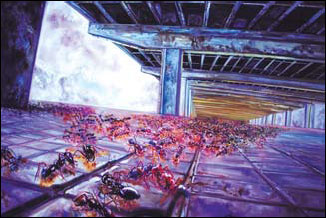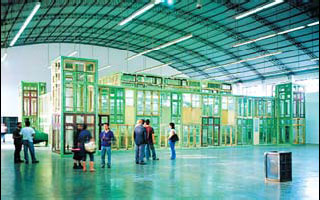What's New
Ants, skeletons and other matters of art

The unlikely juxtaposition of ancient treasures and exhibits from vanguard artist Zhang Xiaotao might surprise visitors to the Arthur M. Sackler Museum of Art and Archeology.
The exhibition entitled Rebirth presents Zhang's latest works ranging from videos, paintings and installations, to photography and tackles such philosophical issues as uncertainty, decay, death, and rebirth of life.
At the museum in Peking University, the mysterious chanting of a Tibetan Buddhist is heard in the exhibition halls; a legion of larger-than-life insects, animals, poppy flowers and weeds take over artificial hills, symbolic of an industrial landscape devoid of humans in the museum's courtyard.
A corridor, fully covered by copies of Zhang's handwritten notes about art projects, leads viewers from one exhibition hall hanging his religion-inspired oil works and photos, to a dark room with a strange video and horrifying images such as ants pulling chariots ridden by human skeletons.
The show is the first in a new initiative by Peking University to seek dialogue between historical and archaeological art with vanguard contemporary art, curator Yuan Gong says. The exhibition ends on January 30.
Today's talent cheers Olympics
The Today Art Museum has launched its annual project Discovering the Young Talents: Cheers to the Beijing Olympics, last week in Beijing.
Art majors from over 30 art academies and schools across the nation have been asked to submit works to be considered for the show, says museum director Zhang Zikang.
These works will include ink art, oils and mixed media, prints and lithographs, sculptures and installations, videos and cartoons.
A panel of judges comprised of art professors, veteran artists and curators will decide in early September which young artists will be included in the exhibition.
The awards include cash prizes and opportunities for creative sessions at studios in the museum or at the China Academy of Oil Painting, a center made famous by oil painter Yang Feiyun.
Last year's project attracted more than 20,000 students and their teachers from more than 22 art academies. Some of the award-winning artists have drawn attention from art galleries and critics, according to curator Li Xiaoqian.
CCAA bestows its verdicts

Winners of the fifth Chinese Contemporary Art Awards (CCAA) were announced on Monday.
Beijing born artist Liu Wei was the winner of Best Artist. The CCAA said he continues to challenge the limitations of experience and international art language. In his installations and conceptual art experiments, he keeps refreshing people's preconceived ideas toward common things.
The 2008 Lifetime Contribution Prize was given to Ai Weiwei for transcending the category of contemporary art in China and reflecting its social and political dynamics and its changing architectural and design spaces.
Tseng Yu-chin, 30, from Taiwan, won the Best Young Artist prize. His art is characterized by a deep and fragile humanism. His concern is the role of the individual in the context of a changing contemporary society, in particular, the demise of the traditional community and family configurations.
At a press conference the jury discussed how independence and creativity survive under the pressure of heavy commercialization.
The biennial award was created in 1997 by former Swiss ambassador and art collector Uli Sigg. The jury members included renowned artists, critics, collectors from China and worldwide.
Most CCAA winners have are recognized by the mainstream international art world. As a result, Chinese contemporary artists have come to value the award.
China Daily
(China Daily 01/17/2008 page18)














